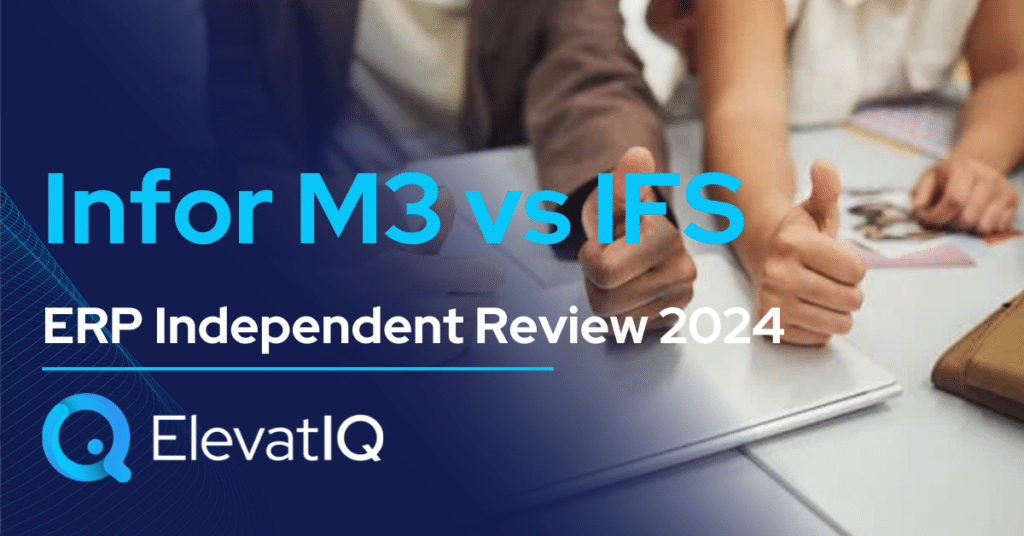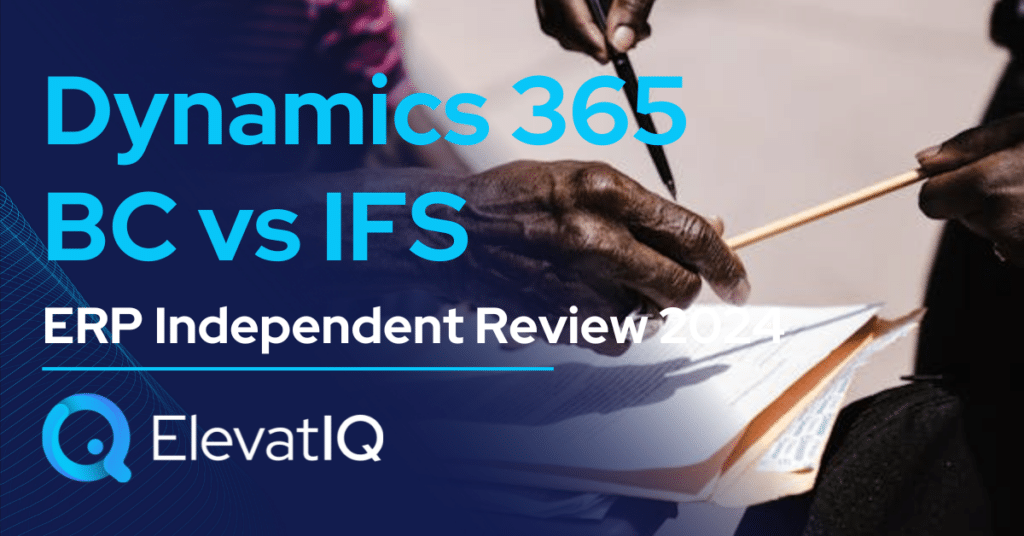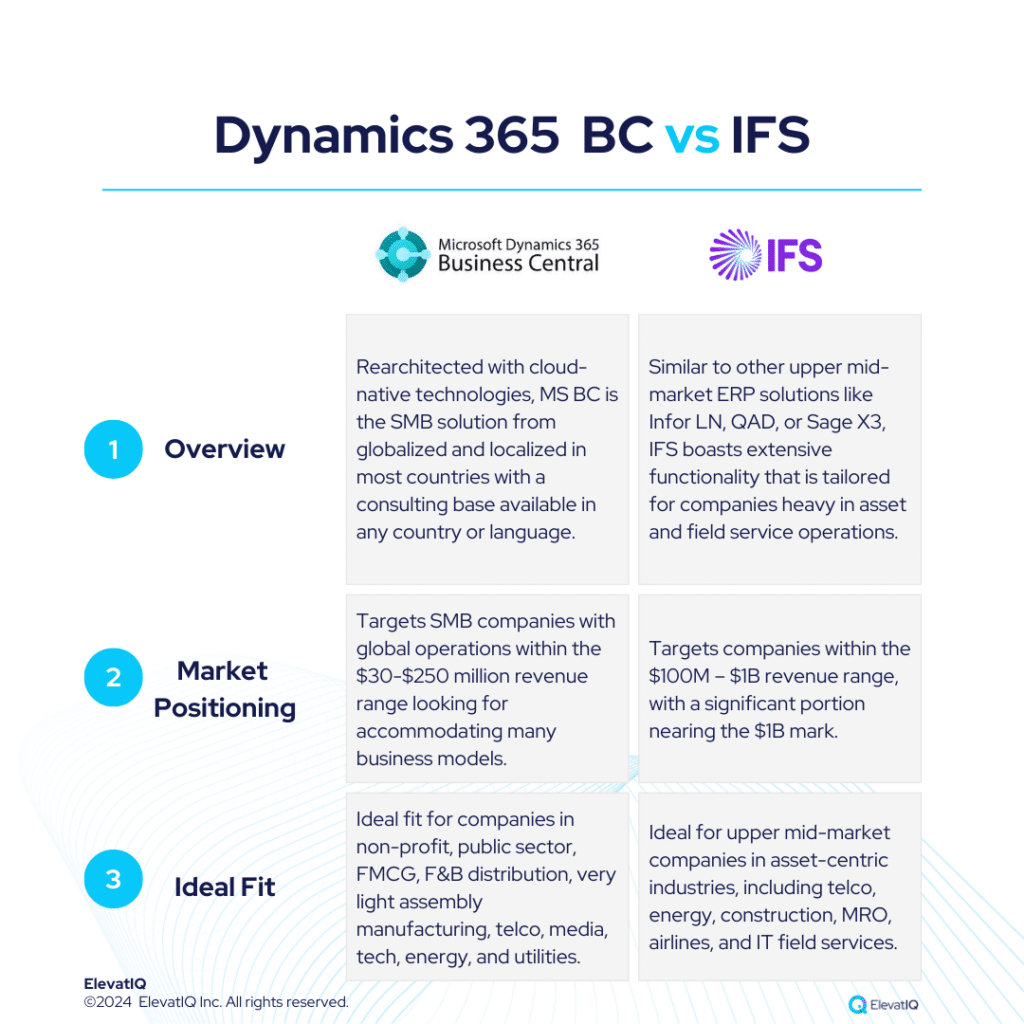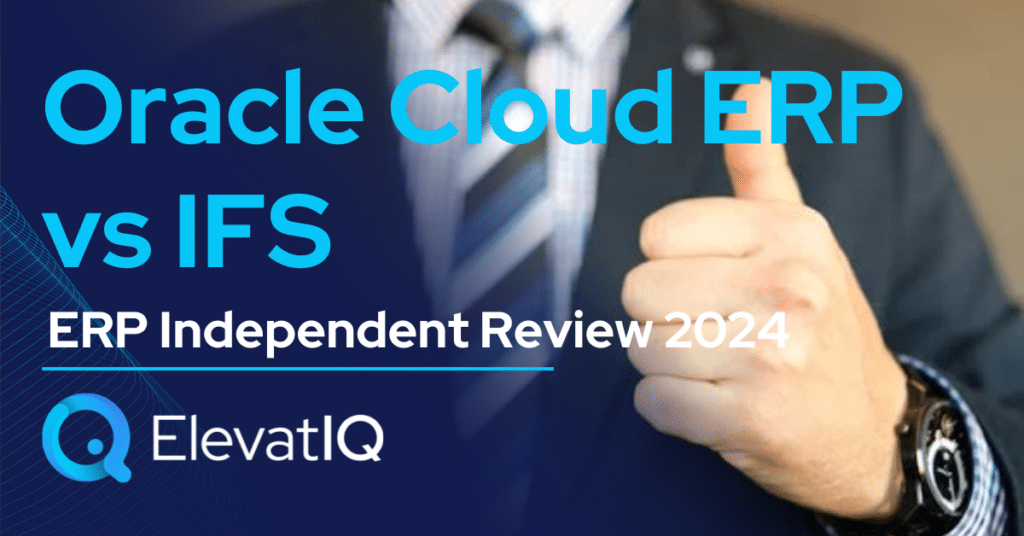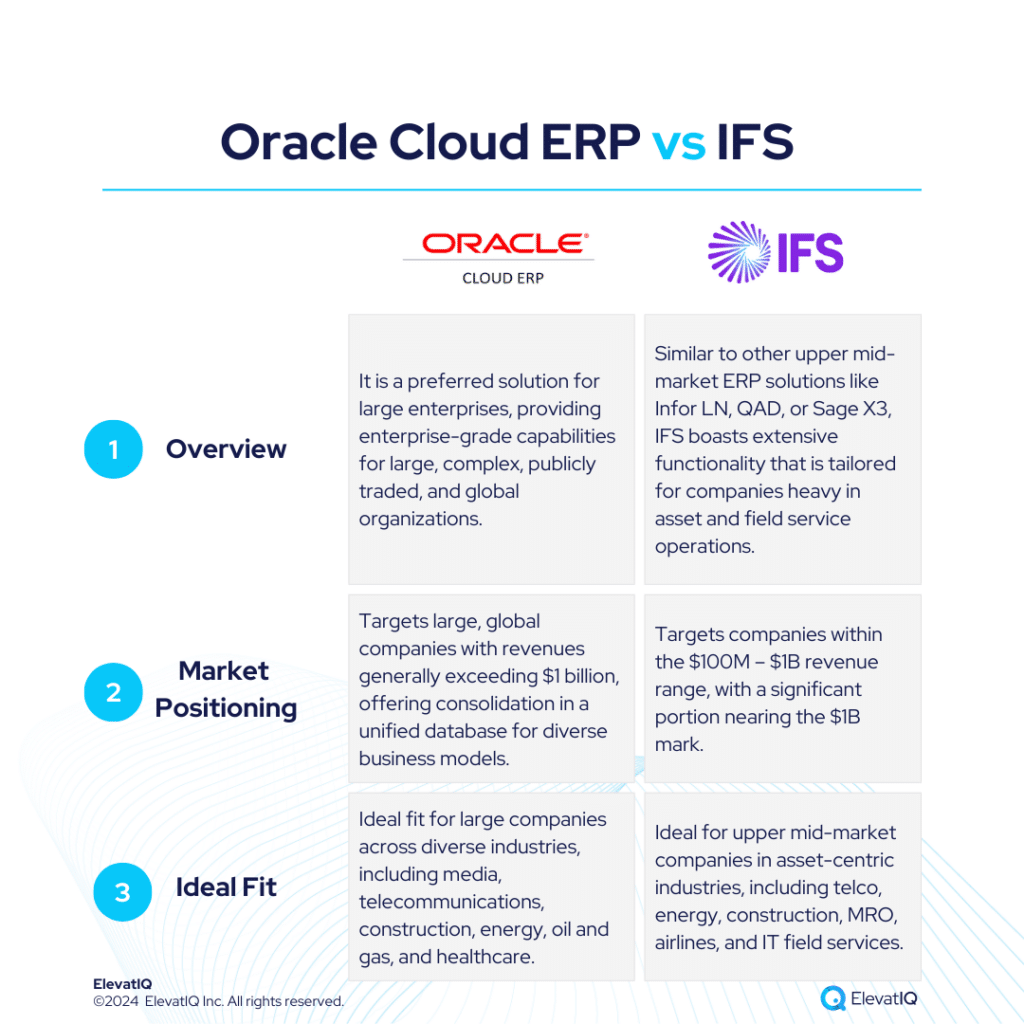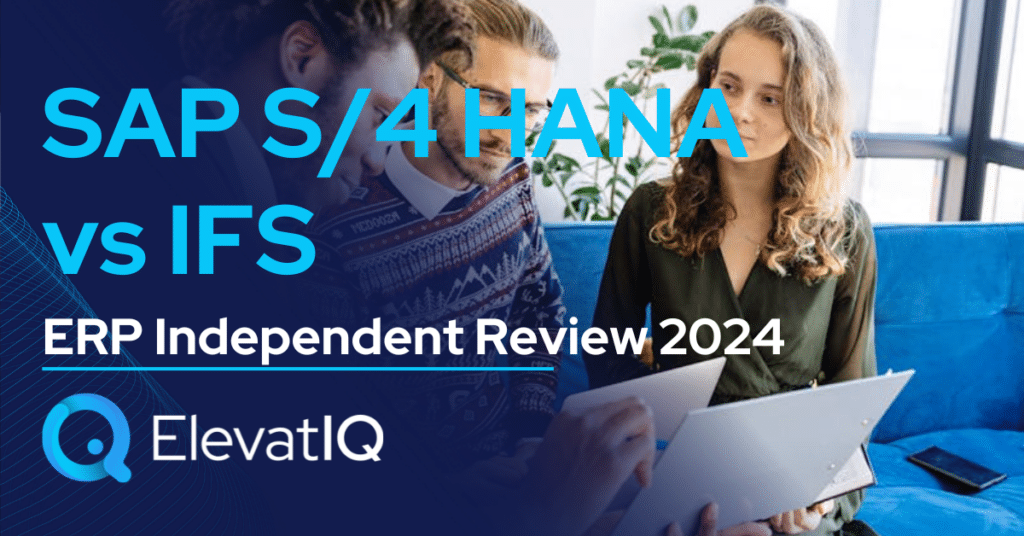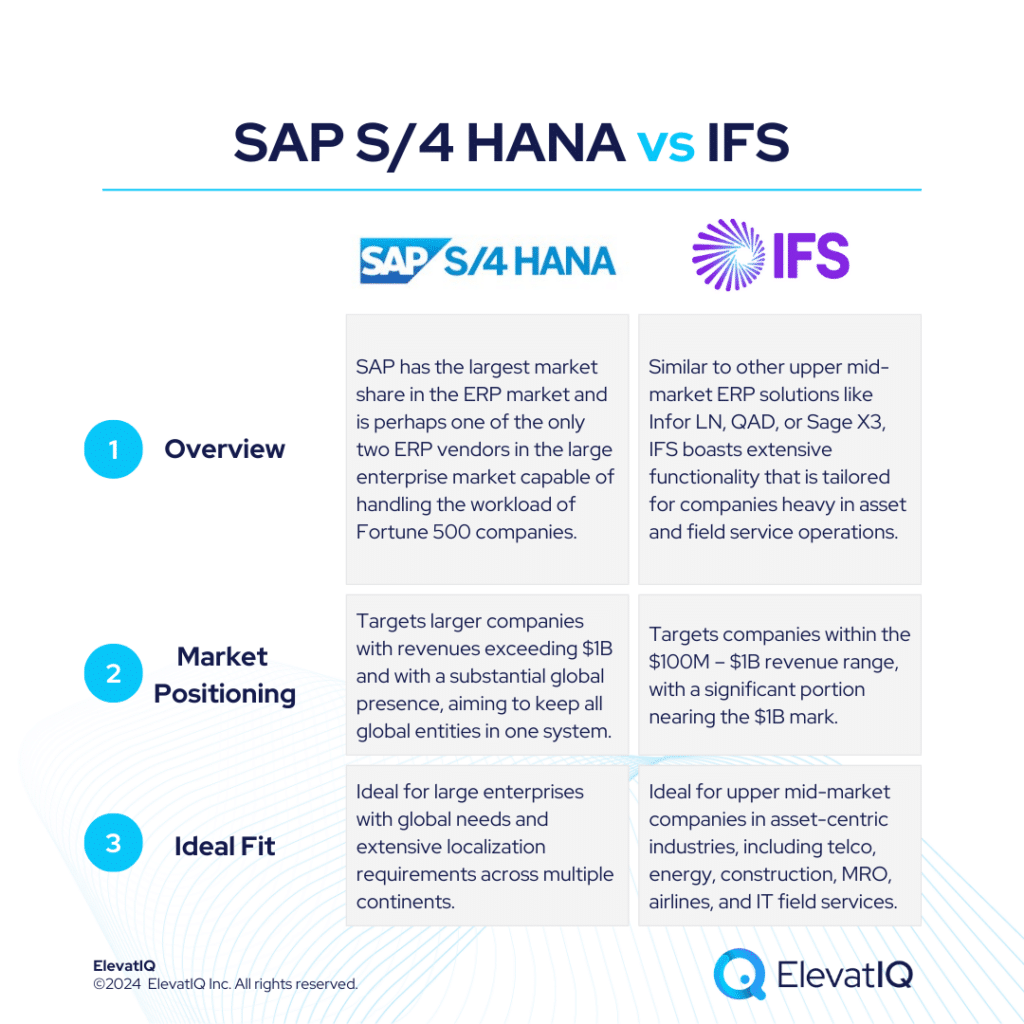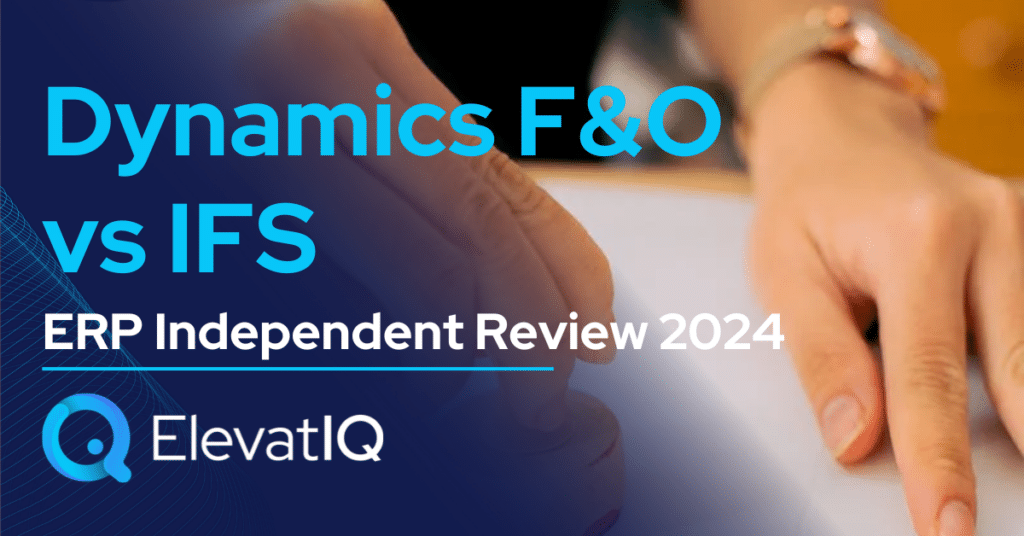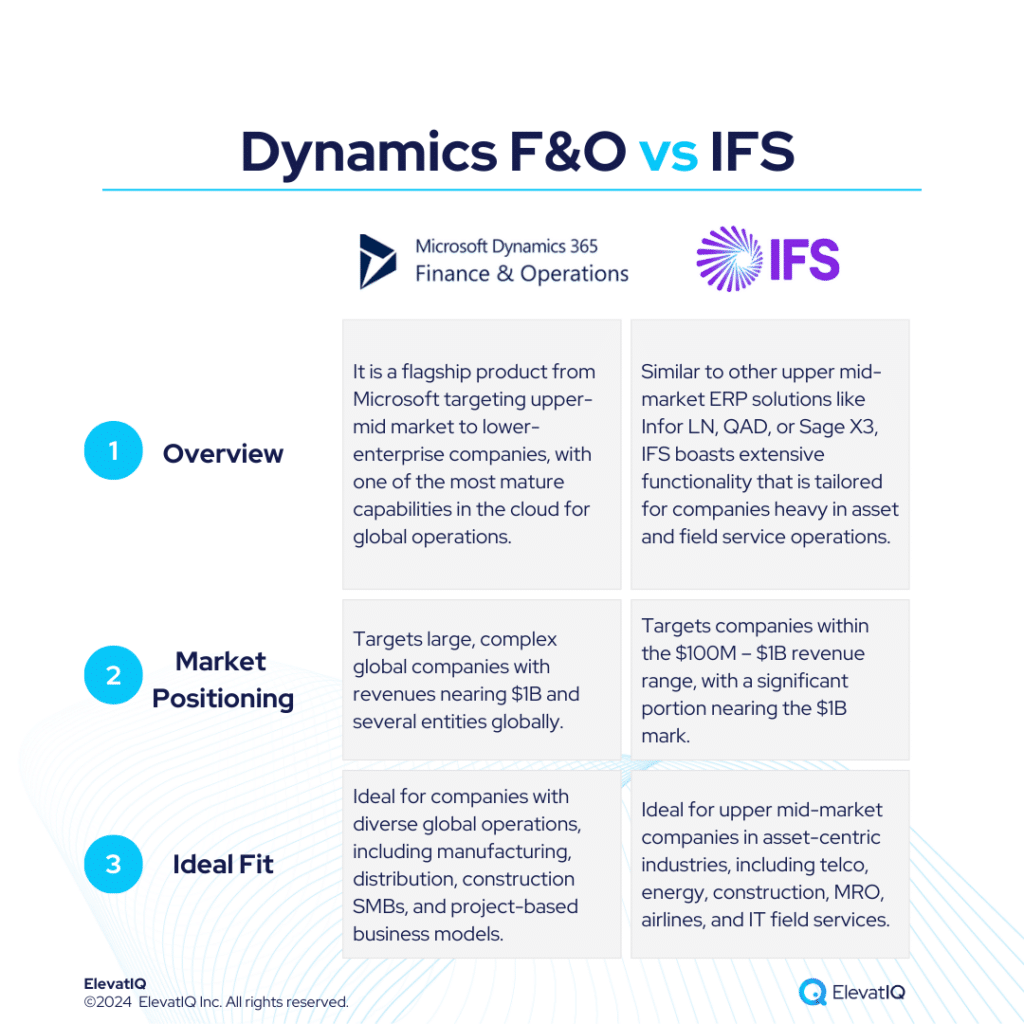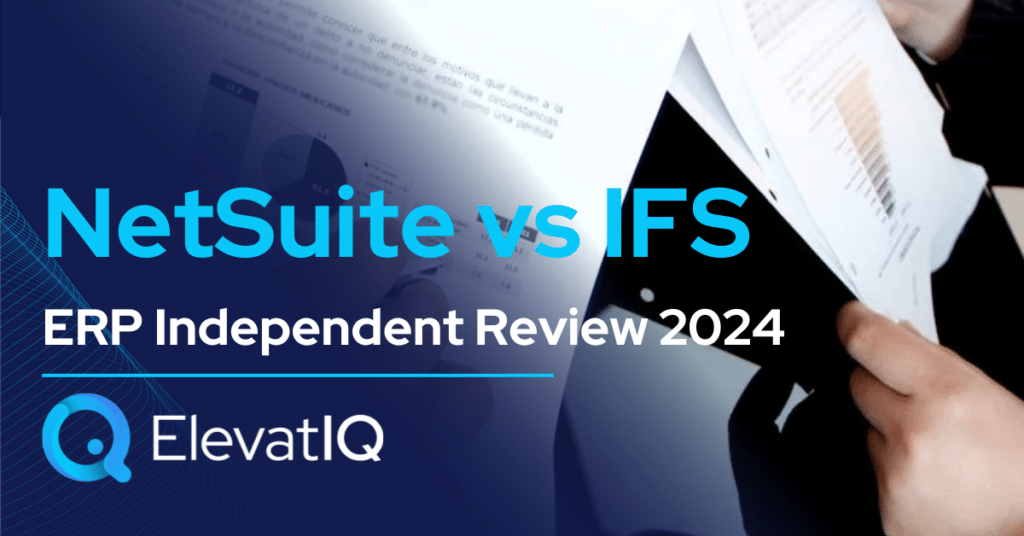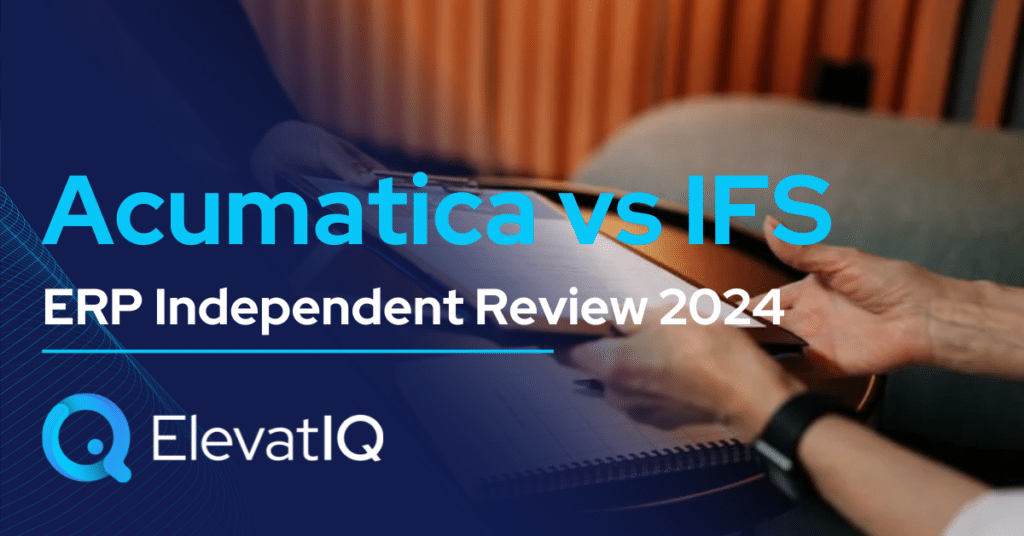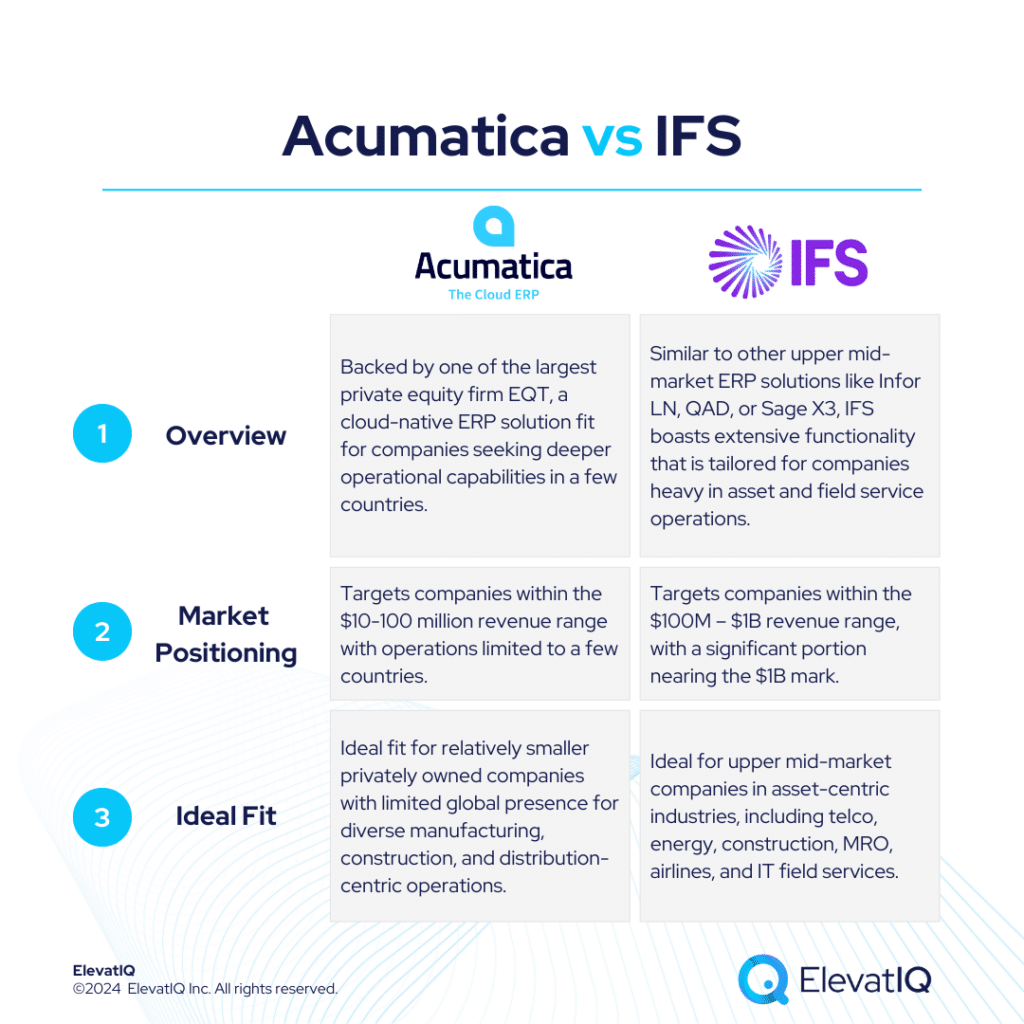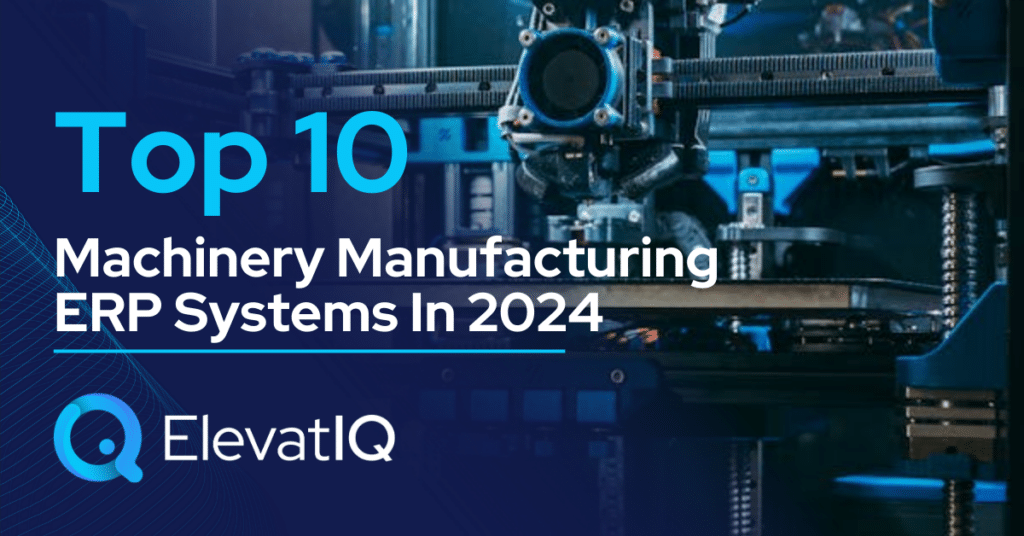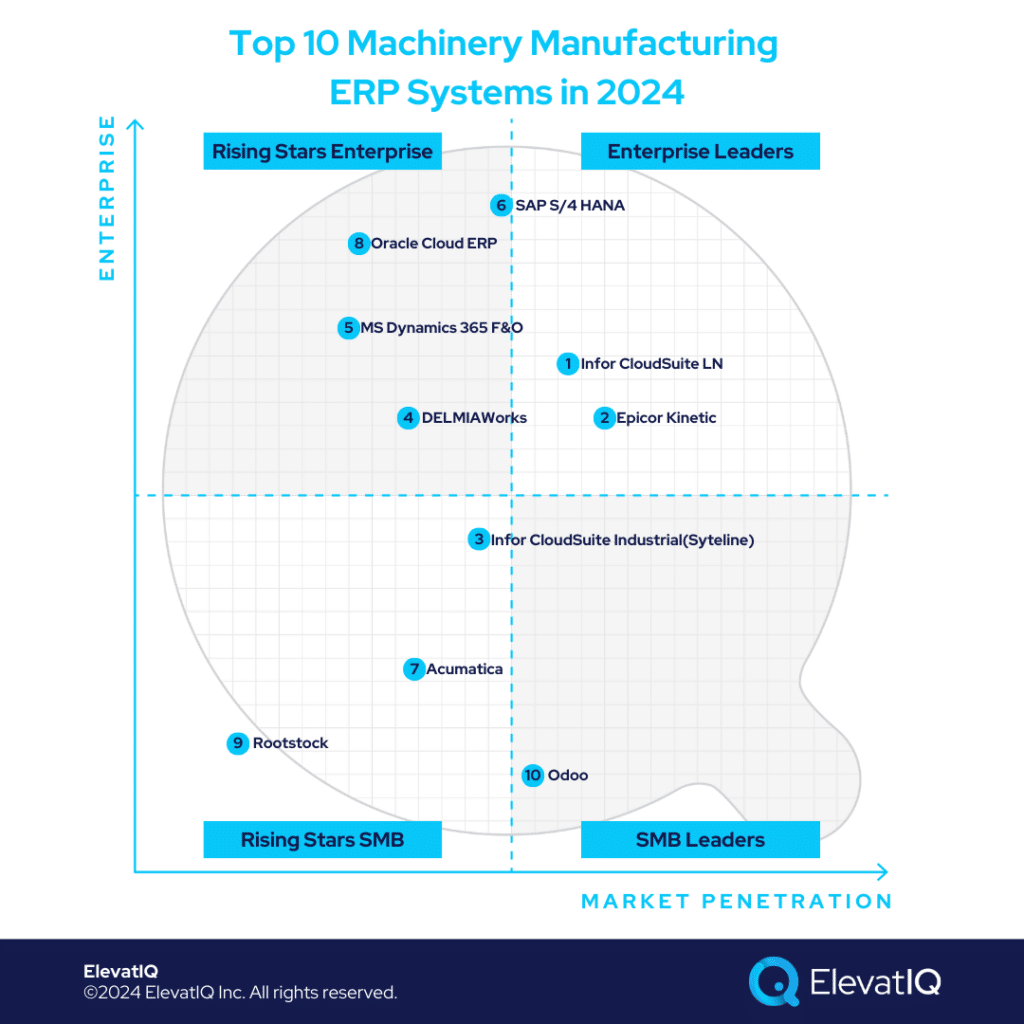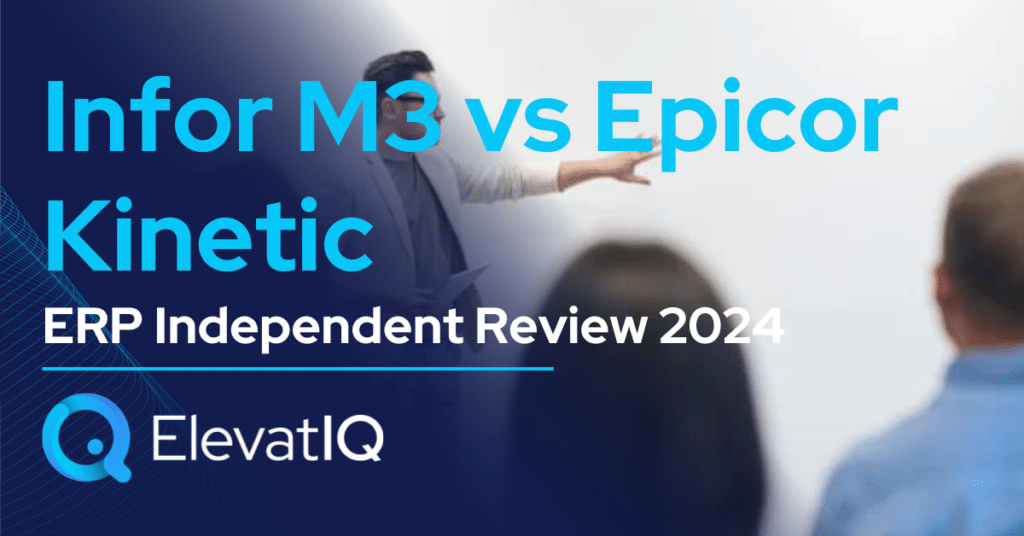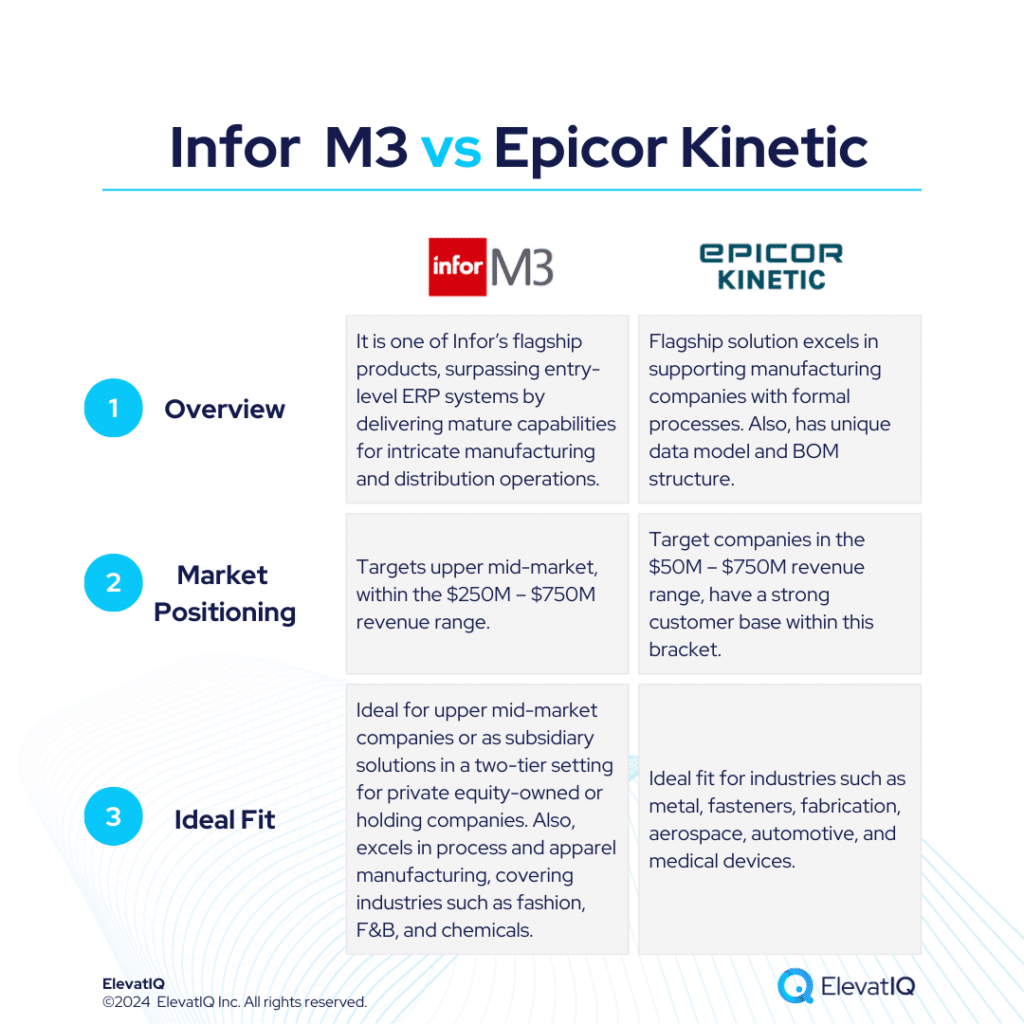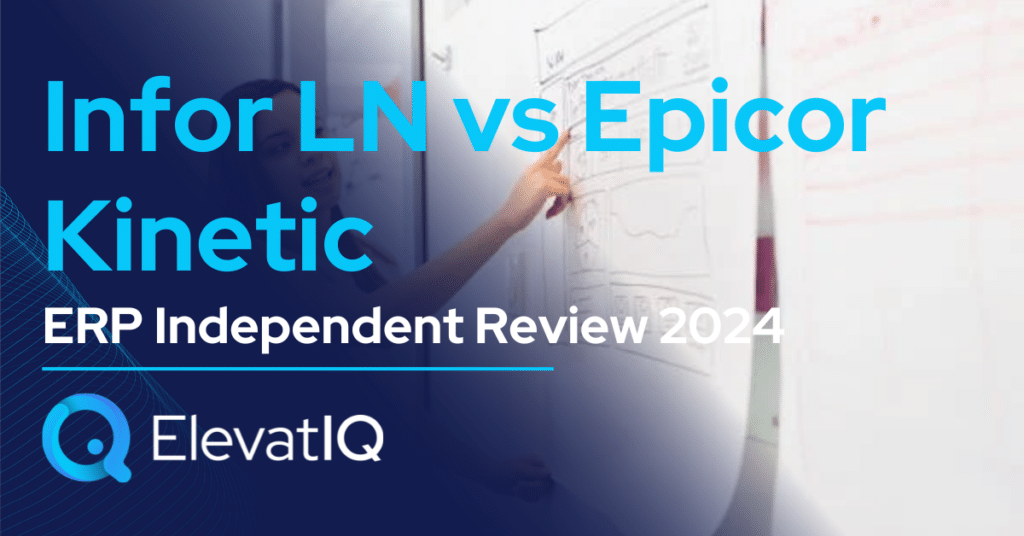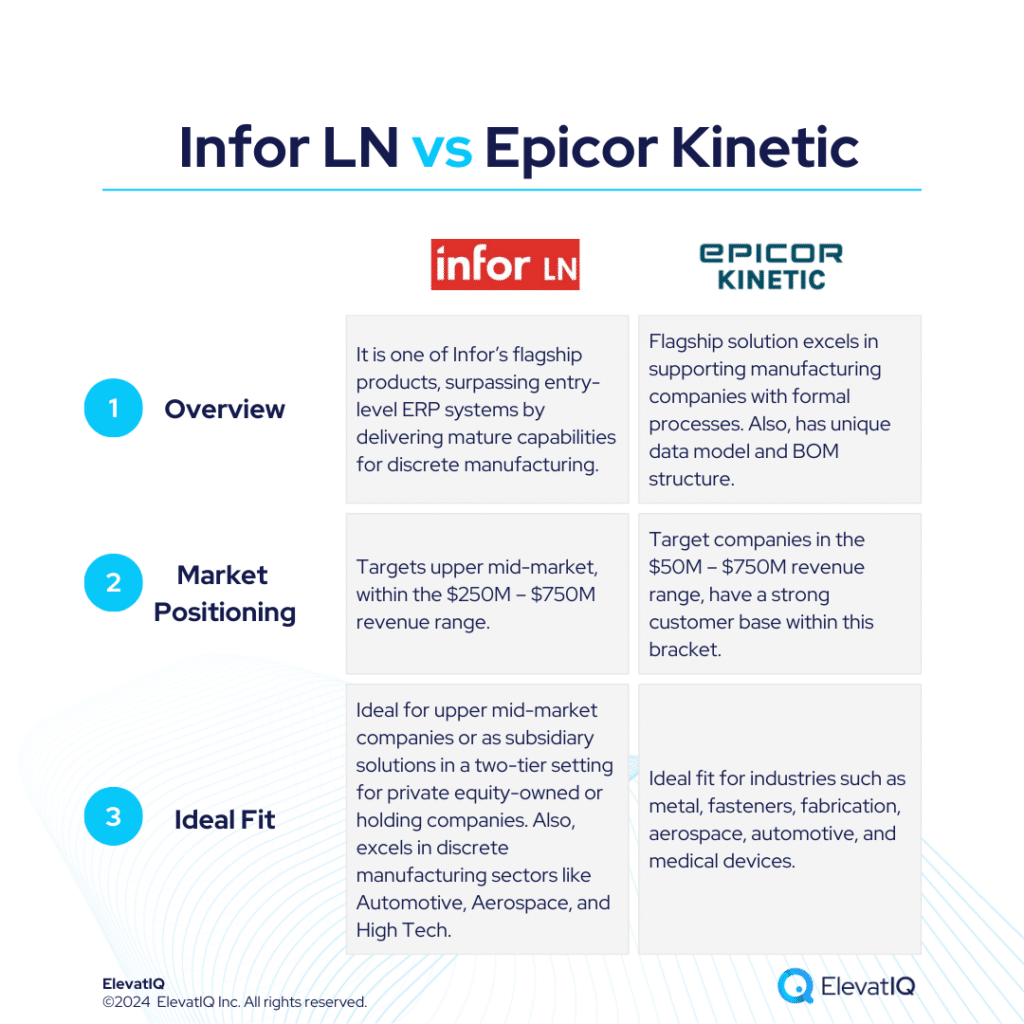Infor M3 vs IFS ERP Independent Review 2024
Infor M3 targets companies particularly surpassing entry-level ERP systems like Acumatica, Infor CSI, or NetSuite. On the other hand, similar to other upper mid-market ERP solutions like Infor LN, QAD, or Sage X3, IFS boasts extensive functionality that is tailored for companies heavy in asset and field service operations. Infor M3 also delivers mature capabilities for intricate manufacturing and distribution operations. It is successful in the upper mid-market, particularly targeting the $250M – $750M revenue range. Whereas, IFS is positioned for companies within the $100M – $1B revenue range, with a significant portion nearing the $1B mark.
Infor M3 also provides a superior suite experience akin to SAP and Oracle, featuring enterprise-grade best-of-breed functionalities, including PLM, WMS, WFM, BI, and a Supply Chain collaboration platform. On the other hand, IFS boasts robust global, multi-entity capabilities and operates as a cloud-native solution. IFS not only delivers functional capabilities but also efficiently manages the transactional workload of upper-mid-market companies.
Infor M3 boasts extensive features tailored for process and apparel manufacturing, covering industries such as fashion, F&B, and chemicals. It is also adept at facilitating advanced global operations, particularly for companies spanning multiple countries seeking to optimize cost synergies globally. On the other hand, IFS appeals to enterprises seeking mature, industry-specific capabilities, reducing the need for extensive development with vanilla ERP systems like SAP or Oracle. Therefore, choosing between Infor M3 vs IFS requires a detailed examination, and this comparison offers valuable insights for ERP selection projects. Let’s delve deeper into the specifics.
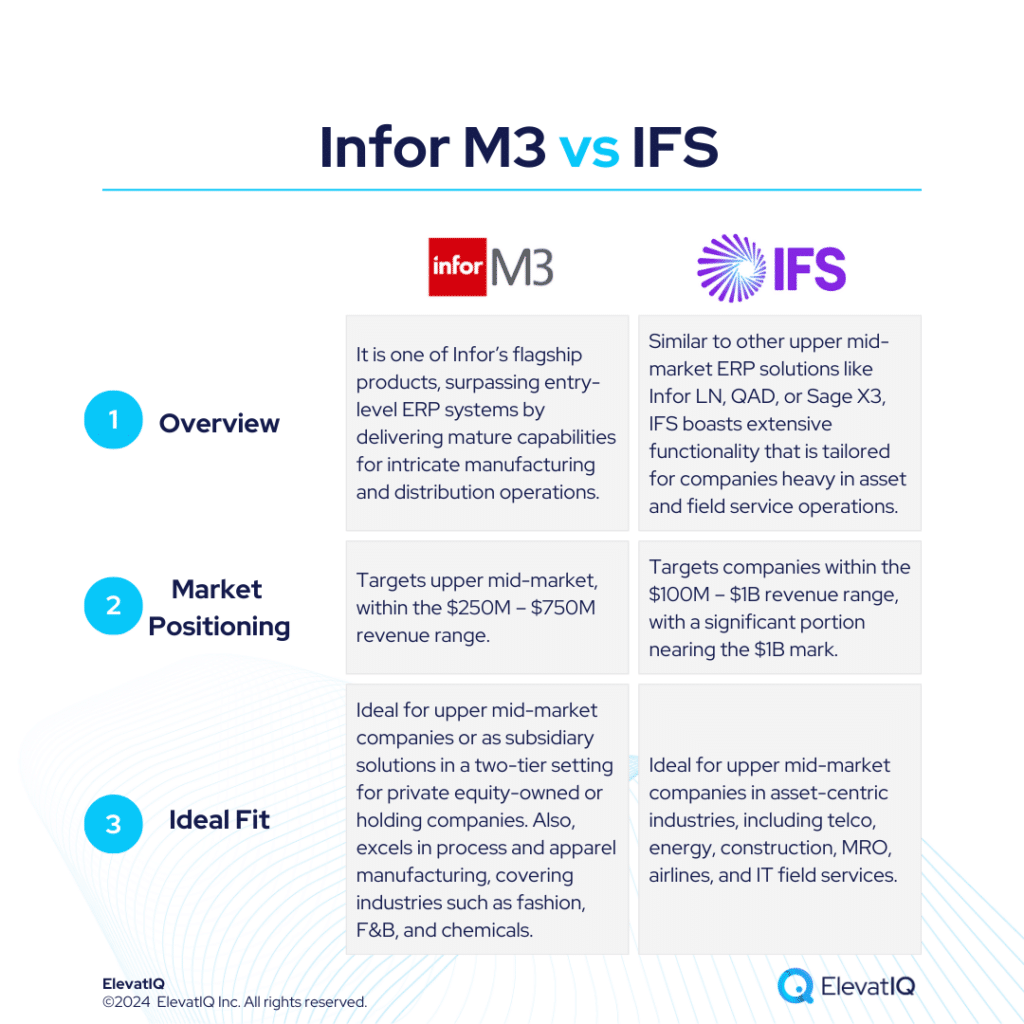

| Infor CloudSuite M3 | IFS | |
| Started in | 2006 (Acquired by Infor) | 1986 |
| Ownership by | Koch Industries | EQT |
| No. of customers | 1,000+ | 6,500+ |
What Is Infor CloudSuite M3?
Infor CloudSuite M3, is one of Infor’s flagship solutions. Sharing similar suites with Infor LN and built on the Infor OS platform, it is also successful in the upper mid-market, targeting the $250M – $750M revenue range. Positioned for companies particularly surpassing entry-level ERP systems like Acumatica, Infor CSI, or NetSuite, this solution delivers mature capabilities for intricate manufacturing and distribution operations. Infor CloudSuite M3 also provides a superior suite experience akin to SAP and Oracle, featuring enterprise-grade best-of-breed functionalities, including PLM, WMS, WFM, BI, and a Supply Chain collaboration platform.
Infor CloudSuite M3 boasts extensive features tailored for process and apparel manufacturing, covering industries such as fashion, F&B, and chemicals. It is also adept at facilitating advanced global operations, particularly for companies spanning multiple countries seeking to optimize cost synergies globally. The native capabilities of Infor CloudSuite M3 address global trade and compliance concerns, which are particularly crucial for international business operations.
While Infor CloudSuite M3 serves as an excellent operational solution for a 2-tier architecture for enterprise companies, its limited focus on certain industries might not be the best fit for enterprise companies diversifying their operations or aggressive with their M&A strategy. The intricate data model and BOM demand significant internal expertise and also external advisory assistance to extract operational efficiencies. Notably, the technology landscape for Infor CloudSuite M3 remains somewhat patchy and less modern compared to its competitors. Furthermore, the ecosystem and consulting support for this solution is relatively limited. Despite these challenges, Infor CloudSuite M3 stands out as a robust manufacturing solution for upper mid-market companies with budget constraints.
What Is IFS?
Similar to other upper mid-market ERP solutions like Infor LN, QAD, or Sage X3, IFS also boasts extensive functionality. This functionality is particularly tailored for companies heavy in asset and field service operations. Positioned uniquely in the market, IFS also appeals to enterprises seeking mature, industry-specific capabilities, reducing the need for extensive development with vanilla ERP systems like SAP or Oracle. IFS serves as an optimal alternative in the upper mid-market space, offering standalone best-of-breed asset management and field service capabilities or a comprehensive ERP solution particularly crafted for asset-centric industries, including telco, energy, construction, MRO, airlines, and IT field services.
The IFS data model also surpasses the complexity of smaller systems like Acumatica or NetSuite, demanding an experienced internal team and external advisory support to successfully align process and data codings with the intricate IFS data model. It is an ideal choice for upper mid-market companies outgrowing smaller systems, such as Acumatica or NetSuite, and requiring mature capabilities for enterprise-wide asset scheduling and maintenance. IFS not only delivers functional capabilities but also efficiently manages the transactional workload of upper-mid-market companies.
IFS boasts robust global, multi-entity capabilities and also operates as a cloud-native solution. The majority of IFS customers fall within the $100M – $1B revenue range, with a significant portion nearing the $1B mark. While IFS has its roots in Europe, they have been trying to grow its presence in North America. In 2023, IFS made strategic acquisitions to enhance its AI and shop floor capabilities.
Infor M3 vs IFS Comparison
Navigating the choice between Infor M3 vs IFS is a significant decision for businesses particularly looking for operational efficiency and strategic alignment. Thus, this section delves into the comprehensive comparison of Infor M3 vs IFS across various critical dimensions.
| Infor CloudSuite M3 | IFS | |
| Global Operational Capabilities | Robust financial hierarchies and global trade compliance functionality integrated. | Has robust global multi-entity capabilities. |
| Diverse Capabilities | Supports diversified manufacturing business models. | Companies with a diverse business model, such as manufacturing or expecting changes with the model, might struggle. |
| Best-of-breed Capabilities | Best-of-breed integrations provided out-of-the-box. | Has one of the strongest field service and also asset management capabilities. |
| Last-mile Capabilities | Last-mile capabilities along with breadth of capabilities for diversified manufacturing business models. | Often require add-ons for specific micro-verticals. |
| Operational Functionalities | Legacy solution with limited cloud-natve capabilities. | The operational capabilities would be deeper in some areas, making it a best-of-breed option for enterprise-grade asset and field service-centric use cases used alongside another ERP as a corporate ledger. |
| Integration Capabilities | Tools such as HCM, PLM, data lake, ERP, WMS, TMS, and advanced supply chain planning, are pre-integrated. | Good fit for those seeking best-of-breed field service capabilities for a subsidiary or integrated with a corporate financial ledger. |
| Manufacturing Capabilities | Delivers mature capabilities for apparel, F&B, and chemical manufacturing. | Has comparatively limited manufacturing capabilities. |
| Pricing Model | Subscription-based | Recurring subscription-based model |
| Key Modules | 1. Financial Management 2. Manufacturing Operations 3. Enterprise Asset Management 4. Supply Chain Management 5. Customer Sales and Service 6. Application Foundation | 1. Manufacturing 2. Supply Chain Management 3. Projects 4. Finance 5. Human Capital Management 6. Procurement 7. Customer Relationship Management 8. Commerce |
Infor M3 vs IFS Feature Comparison
Both platforms offer a plethora of features and functionalities designed to streamline business operations and enhance efficiency. In this feature comparison, we delve into particularly the distinct capabilities of Infor M3 vs IFS across various critical dimensions, providing insights to aid businesses in making informed decisions regarding their ERP selection. Thus, this section discusses features under each of the following modules, particularly financial management, supply chain management, and manufacturing management.
Financial Management Comparison
In this section, we are discussing a detailed comparison of the financial management capabilities particularly offered by Infor M3 vs IFS. By examining their respective strengths and functionalities, particularly in managing financial processes. Businesses can therefore gain valuable insights to determine the best-suited ERP solution for their financial management needs.
| Infor CloudSuite M3 | IFS | ||
| Financial Management | General Ledger | Enables organizations to manage financial transactions, maintain accurate balances, and generate complete financial statements. | Centralizes financial data management, enabling accounting, reporting, and analysis. |
| Accounts Receivable and Accounts Payable | Supports analysis across all accounting dimensions, including non-reconciled data for the AP model. | Streamlines customer invoicing, payment processes, vendor invoices and payments. | |
| Cash Flow Management | Provides complete control over accounts receivable and cash flow processes, unifying all AR information to monitor cash collection and enhance productivity and efficiency. | Enables accurate planning and forecasting of cash activities, and analyze liquidity and cash positions. | |
| Currency Management | Enables currency conversion for better monetary analysis, allowing amounts to be expressed in transaction, division, and company currencies, with a default exchange rate type for conversions. | Handles transactions in multiple currencies, automatically calculating exchange rates and converting transactions into the base currency. | |
| Tax Management | Ensures accurate VAT calculation and recording for each country, automating tax calculations based on recipient location and country-specific rules, and maintaining financial compliance. | Automates and manages tax calculations, compliance, and reporting across multiple jurisdictions. |
Supply Chain Management Comparison
In this comparison, we explore and analyze the supply chain management capabilities of Infor M3 vs IFS, shedding light particularly on their respective strengths and weaknesses.
| Infor CloudSuite M3 | IFS | ||
| Supply Chain Management | Warehouse Management | Optimizes operations with inventory management, labor management, 3PL billing, and 3D visualization, enhancing efficiency and interactivity. | Enables businesses to efficiently manage warehouse operations by automating the physical storage and retrieval of inventory items. |
| Service Management | Offers work order processing, maintenance, material management, and operation reporting, aiding global manufacturers, distributors, and after-sales service providers in managing complex value chains. | Enables organizations to efficiently manage their field service operations, including planning, scheduling, dispatching, and mobile workforce management. | |
| Inventory Management | Provides advanced statistical forecasting and stock recommendations for efficient inventory management, as well as supplier and customer rebate management. | Provides real-time visibility into stock movements, allowing businesses to maintain optimal inventory levels by setting reorder points and reducing the risk of overstocking and stock-outs. | |
| Purchase Order Management | Includes automation, vendor payment tracking, payment scheduling, check printing, open purchase order alerts, document management, direct ACH bill payment, and vendor records. | Streamlines the procurement process by automating the creation, tracking, and approval of purchase orders, ensuring efficient and accurate order fulfillment. | |
| Requisition Management | Specifies nonsystem planned requirements for different types of items, including inventory items, cost items, and service items. | Simplifies the procurement process by allowing users to create, track, and approve requisitions, ensuring that all purchase requests are efficiently managed and fulfilled. |
Manufacturing Management Comparison
In this comparison, we explore and analyze the manufacturing management capabilities of Infor M3 vs IFS, shedding light, particularly on their respective strengths and weaknesses.
| Infor CloudSuite M3 | IFS | ||
| Manufacturing Management | Production Planning | Assists manufacturers in addressing production demand with the agility to adjust to fluctuating schedules, unforeseen equipment malfunctions, delayed deliveries from suppliers, and other unexpected occurrences affecting operations on the factory floor. | Optimizes manufacturing processes by providing tools for capacity planning, production scheduling, material requirements planning, and shop floor control, ensuring real-time visibility and efficiency. |
| BOM and Routing | Let’s you efficiently plan and manage inventories, costs and manufacturing processes. | Streamlines manufacturing by detailing the components and materials needed for production and defining the sequence of operations required to produce a finished product. | |
| Advanced Planning and Scheduling | Let’s you create a more streamlined and accurate production scheduled, better enforce delivery dates and optimize for capacity. | Enhances manufacturing efficiency by optimizing resource allocation, production schedules, and material requirements through advanced algorithms and real-time data analysis. |
Pros of Infor M3 vs IFS
When evaluating ERP solutions, understanding the distinct advantages of Infor M3 vs IFS is crucial. In this section, we are particularly exploring the strengths of Infor M3 vs IFS across various dimensions. Thus, shedding light on their respective capabilities and functionalities.
| Infor CloudSuite M3 | IFS |
| Ideal for upper mid-market companies or as subsidiary solutions in a two-tier setting for private equity-owned or holding companies. | One of the most consistent user experiences that have been rearchitected and modernized. |
| It can support multi-entity and supply-chain collaboration with international vendors, but the global footprint might not be as comprehensive as that of larger peers such as SAP S/4 HANA. | One of the strongest asset-management capabilities for organizations with very thick asset and predictive maintenance needs. |
| Most tools that process and apparel manufacturers would require, such as HCM, PLM, data lake, ERP, WMS, TMS, and advanced supply chain planning, are all pre-integrated with Infor CloudSuite M3. | Designed to handle large programs where consolidated visibility would be critical without ad-hoc arrangements. |
| While most smaller solutions might require ad-hoc arrangements for global financial operations, Infor CloudSuite M3 has them natively built. | Unique financial workflows to support complex project manufacturing programs. |
Cons of Infor M3 vs IFS
Just like recognizing strengths is important, it’s also crucial to weigh the specific drawbacks of Infor M3 vs IFS. Therefore, in this section, we will delve into the limitations and challenges associated with Infor M3 vs IFS across various operational and financial dimensions.
| Infor CloudSuite M3 | IFS |
| The limited focus on certain business models poses the risk of requiring other ERP systems to support complex and diverse business operations. | Has a limited presence in North America and also a lean partner ecosystem. |
| Private equity and holding companies requiring global solutions with a tier-2 solution at the subsidiary level might not be the best use of Infor CloudSuite M3’s strengths. | Companies with a diverse business model, particularly might outgrow or struggle with the solution. |
| Infor CloudSuite M3 is a legacy solution with limited cloud-native capabilities such as universal search, mobile experience, etc. | Companies involved with the M&A or the ones part of the PE portfolio might not be the best fit for IFS. |
| The consulting base and marketplaces are virtually non-existent for Infor CloudSuite M3. | IFS might not be the best fit to be used just as the corporate ledger for large project manufacturing enterprises. |
Conclusion
In conclusion, both Infor M3 vs IFS offer comprehensive ERP solutions tailored for upper mid-market companies, yet they serve distinct industries and operational needs. Infor M3 is also ideally suited for companies in process manufacturing, fashion, and distribution, providing robust global capabilities and industry-specific functionalities. Its focus on advanced global operations, particularly in manufacturing, makes it a strong contender for businesses seeking cost optimization and efficiency across borders. However, its limited presence in North America and legacy cloud capabilities may not fully meet the needs of enterprises with more diverse or fast-evolving operations.
On the other hand, IFS excels in asset-centric industries such as energy, construction, and field services, offering one of the most robust asset management solutions available. Its cloud-native architecture, coupled with its focus on global, multi-entity capabilities, makes it a versatile choice for companies that require advanced field service and asset management. However, IFS’s more limited presence in the North American market and potential gaps in supporting highly diversified business models may pose challenges for companies with more complex needs.
Both systems have their strengths and limitations, so businesses should carefully evaluate their specific needs and growth aspirations to determine the most suitable ERP solution. Also, seeking assistance from an independent ERP consultant can significantly aid the decision-making process. To get a 360-degree view of feature comparisons, it’s essential to explore not only Infor M3 vs. IFS but also insights from other analyses such as Infor M3 vs. NetSuite, SAP S/4 HANA, Oracle Cloud ERP, MS Dynamics 365 F&O, MS Dynamics 365 BC, Acumatica, Infor LN, and Epicor Kinetic.

FAQs
Infor M3 vs IFS ERP Independent Review 2024 Read More »

